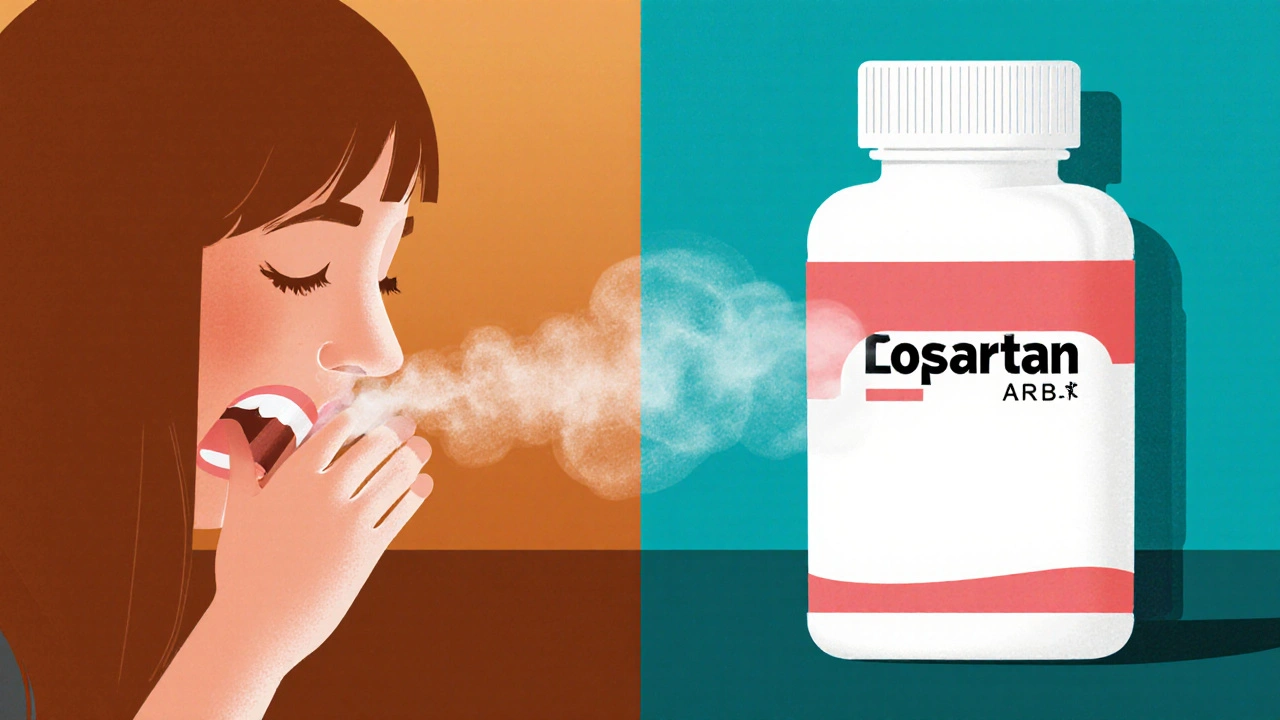Capoten vs Alternatives: Captopril Comparison Guide
 Oct, 10 2025
Oct, 10 2025
Capoten vs Alternatives Comparison Tool
Comparison Results
| Drug/Class | Dry Cough | Angioedema Risk | Elevated Potassium | Kidney Impact |
|---|---|---|---|---|
| Capoten (ACE inhibitor) | 10–20% | Rare, but higher risk than ARBs | 5–10% | Monitor creatinine; dose-adjust if needed |
| Lisinopril (ACE inhibitor) | 5–15% | Rare | 4–8% | Similar monitoring |
| Enalapril (ACE inhibitor) | 6–12% | Rare | 5–9% | Similar monitoring |
| Losartan (ARB) | 1–2% (often none) | Very rare | 2–5% | Kidney monitoring still required |
| Valsartan (ARB) | 1–2% | Very rare | 2–5% | Same monitoring |
Trying to decide whether Capoten (captopril) is the right choice for your blood‑pressure or heart‑failure needs can feel like walking through a maze of drug names, side‑effects, and price tags. This guide cuts through the clutter by laying out what captopril actually does, which medicines sit in the same family, and how they stack up on effectiveness, safety, and cost. By the end you’ll know which option matches your health profile and budget, and what questions to bring to your doctor.
Key Takeaways
- Capoten is an ACE inhibitor that lowers blood pressure by blocking the conversion of angiotensin I to angiotensin II.
- Common alternatives include other ACE inhibitors (lisinopril, enalapril) and ARBs (losartan, valsartan).
- All these drugs reduce blood pressure, but they differ in dosing frequency, side‑effect profiles, and cost.
- People who develop a dry cough on captopril often switch to an ARB to avoid that symptom.
- Price in 2025 varies widely: generic captopril is cheapest, while some brand‑name ARBs remain more expensive.
What is Capoten?
Capoten is the brand name for captopril, an angiotensin‑converting enzyme (ACE) inhibitor used to treat hypertension, heart failure, and diabetic kidney disease. It was first approved by the FDA in 1981 and quickly became a staple because it works quickly-blood‑pressure reductions can be seen within an hour of the first dose.
Typical adult dosing starts at 12.5mg two to three times daily, with a usual maintenance range of 25‑150mg per day split into two or three doses. The drug is taken by mouth, and food can slow its absorption, so many clinicians recommend taking it on an empty stomach for the most consistent effect.
How Captopril Works
Captopril blocks the enzyme angiotensin‑converting enzyme, preventing the conversion of angiotensin I into the powerful vasoconstrictor angiotensin II. With less angiotensinII, blood vessels relax, blood pressure drops, and the heart doesn’t have to work as hard.
Because the drug also reduces aldosterone secretion, it helps the kidneys excrete sodium and water, lowering blood volume. This dual action makes captopril useful not only for high blood pressure but also for managing heart failure and protecting kidney function in diabetics.

Major Alternatives to Capoten
When doctors or patients look for a different option, they usually stay within two families:
- ACE inhibitors such as lisinopril and enalapril.
- angiotensinII receptor blockers (ARBs) like losartan and valsartan.
ACE inhibitors share the same mechanism of blocking ACE, while ARBs work downstream by preventing angiotensinII from binding to its receptor. The clinical outcomes-blood‑pressure reduction and heart‑failure benefit-are generally comparable, but side‑effect patterns differ.
Side‑Effect Landscape
All drugs in these families can cause low blood pressure, elevated potassium, and kidney function changes, but the frequency of specific complaints varies:
| Drug/Class | Dry Cough | Angioedema | Elevated Potassium | Kidney Impact |
|---|---|---|---|---|
| Capoten (ACE inhibitor) | 10‑20% | Rare, but higher risk than ARBs | 5‑10% | Monitor creatinine; dose‑adjust if needed |
| Lisinopril (ACE inhibitor) | 5‑15% | Rare | 4‑8% | Similar monitoring |
| Enalapril (ACE inhibitor) | 6‑12% | Rare | 5‑9% | Similar monitoring |
| Losartan (ARB) | 1‑2% (often none) | Very rare | 2‑5% | Kidney monitoring still required |
| Valsartan (ARB) | 1‑2% | Very rare | 2‑5% | Same monitoring |
Notice how the dry cough-a hallmark complaint for many patients on captopril-drops dramatically with ARBs. That’s why clinicians often switch patients who can’t tolerate the cough.
Direct Comparison Table
| Drug | Class | Typical Daily Dose | Onset of Action | Half‑Life | Common Side Effects | Average Monthly Cost (US) |
|---|---|---|---|---|---|---|
| Capoten (captopril) | ACE inhibitor | 25‑150mg (split 2‑3×) | 30min-1h | 2-3h | Cough, hyperkalemia, dizziness | $10‑$15 (generic) |
| Lisinopril | ACE inhibitor | 10‑40mg (once daily) | 1h | 12h | Cough, elevated K+, fatigue | $12‑$20 (generic) |
| Enalapril | ACE inhibitor | 5‑40mg (once or twice daily) | 1h | 11h | Cough, rash, hypotension | $13‑$22 (generic) |
| Losartan | ARB | 25‑100mg (once daily) | 1-2h | 2h (active metabolite 6-9h) | Less cough, dizziness, hyperkalemia | $25‑$35 (generic) |
| Valsartan | ARB | 80‑320mg (once daily) | 1-2h | 6h | Minimal cough, headache, high K+ | $30‑$40 (generic) |
All figures reflect retail prices for a 30‑day supply in the United States as of October2025. Insurance coverage can shift these numbers dramatically.
Efficacy and Safety: What the Data Show
Large meta‑analyses from the past five years confirm that ACE inhibitors and ARBs reduce systolic blood pressure by an average of 10‑12mmHg when used as monotherapy. Head‑to‑head trials (e.g., ONTARGET, 2022) found no statistically significant difference in major cardiovascular events between high‑dose ACE inhibitors and high‑dose ARBs.
However, patient‑reported outcomes reveal a clear split: about 12% of people on captopril stop treatment because of cough, while less than 2% on losartan report the same issue. For those with a history of angio‑edema, ARBs are often the safer route because the risk of angio‑edema is about 0.1% with ACE inhibitors versus 0.02% with ARBs.
Kidney protection is comparable across the classes, as long as the dose is adjusted for creatinine clearance. The biggest safety red‑flag remains hyperkalemia-especially when combined with potassium‑sparing diuretics or mineral‑corticoid‑receptor antagonists. Regular labs every 3-6months keep this risk in check.

Cost and Insurance Landscape in 2025
Generic captopril remains the most affordable ACE inhibitor, typically under $20 per month. Lisinopril and enalapril are only slightly pricier, while ARBs sit higher due to newer patents that have only partially expired. Many insurers place ARBs in a higher tier, requiring higher co‑pays or prior‑auth.
If cost is a barrier, ask your pharmacist about dose‑packing-some pharmacies dispense a 90‑day supply at a 15% discount. For patients on Medicare Part D, the “Donut Hole” can make a $30 ARB feel like $80, so an ACE inhibitor might be the more budget‑friendly choice.
Choosing the Right Option for You
- Identify your primary goal. If you need rapid blood‑pressure control (e.g., hypertensive crisis), captopril’s quick onset can be useful.
- Check tolerance. A persistent dry cough or a history of angio‑edema points toward an ARB.
- Look at kidney function. All ACE/ARBs require dose adjustments when eGFR<30mL/min; talk to your clinician about baseline labs.
- Factor in cost. If your insurance favors a generic ACE inhibitor, start there; you can switch later if side‑effects appear.
- Consider dosing convenience. Once‑daily agents like lisinopril or losartan improve adherence compared with multiple daily doses of captopril.
Remember, no online guide replaces a personalized medical assessment. Use this checklist as a conversation starter with your prescriber.
Frequently Asked Questions
Can I take Capoten with a potassium‑sparing diuretic?
Yes, but you’ll need close monitoring of blood potassium and kidney function. The combination can push potassium levels too high, especially in people with reduced kidney clearance.
Why does captopril need to be taken on an empty stomach?
Food slows the absorption of captopril, making its blood‑pressure‑lowering effect less predictable. Taking it 1hour before or 2hours after meals gives the most steady results.
Is the cough from captopril dangerous?
The cough itself isn’t harmful, but it can be persistent and affect quality of life. If it bothers you, discuss switching to an ARB with your doctor.
How do ACE inhibitors compare to ARBs for heart‑failure patients?
Both classes improve survival and reduce hospitalizations. Large trials (e.g., PARADIGM‑HF, 2023) show similar outcomes, so the choice often hinges on side‑effect tolerance and cost.
Can I switch from Capoten to an ARB without a washout period?
Generally, a 24‑hour washout is recommended to lower the rare risk of angio‑edema when moving between ACE inhibitors and ARBs. Your doctor will guide the exact timing.
Next Steps and Troubleshooting
If you’ve started captopril and notice any of the following, act promptly:
- Persistent dry cough lasting more than two weeks: Call your prescriber about switching to an ARB.
- Swelling of the face, lips, or tongue: Seek emergency care-this could be angio‑edema.
- Marked drop in blood pressure (feeling faint, dizziness): Ensure you’re not skipping meals and check that you haven’t taken a double dose.
- Lab results showing potassium >5.5mmol/L or creatinine rising: Dose reduction or a temporary pause may be required.
Keep a medication list handy and bring it to every appointment. Knowing the exact name (Capoten), class (ACE inhibitor), and dosage helps clinicians make quick, safe adjustments.
Armed with this comparison, you can weigh the fast‑acting nature of captopril against the convenience and cough‑free profile of newer ARBs. Talk to your healthcare provider about which factor matters most for you-whether it’s symptom control, side‑effect tolerance, or monthly cost. Capoten vs alternatives is less a battle and more a personalized decision.
Javier Muniz
October 10, 2025 AT 19:55Hey folks, if you’re wrestling with that annoying dry cough from captopril, remember you can usually switch to an ARB like losartan without losing blood‑pressure control. The dosing is once‑daily for most ARBs, which many find simpler than the 2‑3 times a day schedule of captopril. Also, keep an eye on your potassium levels, especially if you’re on a potassium‑sparing diuretic. Bring this info to your next appointment and your doc can help you find the most tolerable option.
Sarah Fleming
October 10, 2025 AT 21:13Do you realize that the pharmaceutical giants have engineered captopril’s cough side‑effect to keep us hooked on their pricey ARB alternatives? It’s a grand deception, a silent war waged by the “med‑industry elite” to line their pockets while we suffer. The data they hide is chilling; the cough is not a random bug but a deliberate push toward higher‑margin drugs. Wake up, people, before they prescribe you another cash‑cow disguised as a medication.
Debra Johnson
October 10, 2025 AT 23:26It is imperative, therefore, to assess the risk‑benefit profile of each antihypertensive agent; consequently, one must consider not only efficacy-measured in millimetres of mercury reduction-but also tolerability, especially regarding cough prevalence; moreover, the economic burden cannot be overlooked.
Andrew Wilson
October 11, 2025 AT 01:40Look, captopril works fine but that cough? It's a real pain-like, seriously, who wants to sound like a dad with a sore throat all day? If you're not cool with that, just switch to an ARB-no cough, less hassle. Plus, dosing is easier, so you ain't gotta remember three pills a day. Seriously, do yourself a favor and ask the doc about losartan.
Kristin Violette
October 11, 2025 AT 04:10When we dissect the pharmacodynamics of captopril versus its contemporaries, we encounter a fascinating interplay of enzymatic inhibition and downstream receptor modulation that underscores the principle of therapeutic specificity. The rapid onset-30 to 60 minutes-offers a kinetic advantage in acute hypertensive scenarios, a property that is underappreciated in many primary‑care protocols. However, the pharmacokinetic profile, characterized by a short half‑life of 2–3 hours, necessitates multiple daily dosing, which can erode adherence, especially in polypharmacy contexts. In contrast, agents such as lisinopril and enalapril boast extended half‑lives, enabling once‑daily administration that aligns with circadian rhythms and patient convenience. The cough phenomenon, mediated by elevated bradykinin levels, serves as a clinical biomarker of ACE inhibition, yet it paradoxically drives patients toward angiotensin‑II receptor blockers. ARBs, by circumventing ACE, mitigate this adverse effect while preserving comparable antihypertensive efficacy, as demonstrated in the ONTARGET trial. Economically, generic captopril remains a low‑cost option, often under $15 per month, whereas brand‑name ARBs can exceed $30, a disparity amplified by tiered insurance formularies. From a renal perspective, all agents confer nephroprotective benefits via modulation of intraglomerular pressure, but caution is warranted in hyperkalemic states, particularly when combined with potassium‑sparing diuretics. The clinician’s dilemma, therefore, pivots on balancing rapid therapeutic onset, dosing frequency, side‑effect tolerability, and financial considerations. Moreover, patient‑reported outcomes increasingly prioritize quality of life metrics, wherein a persistent cough can disproportionately affect adherence and satisfaction. Emerging pharmacogenomic data hint at polymorphisms in the ACE gene that may predict cough susceptibility, foreshadowing a future of personalized antihypertensive therapy. In the interim, shared decision‑making remains the cornerstone of optimal regimen selection, integrating clinical evidence with individual patient preferences. Finally, regular monitoring of serum creatinine and electrolytes safeguards against insidious renal compromise, regardless of the chosen agent. This holistic synthesis underscores that no single drug reigns supreme; instead, therapeutic choice is a nuanced algorithmic function of physiological, psychosocial, and economic variables.
In practice, discussing these trade‑offs openly with patients fosters empowerment and improves long‑term cardiovascular outcomes.
Theo Asase
October 11, 2025 AT 06:06The moment the American pharma lobby got wind of captopril’s cheap generic status, they engineered a covert campaign to push the more expensive, foreign‑made ARBs onto our healthcare system. They hide behind “clinical guidelines” while funneling billions into their subsidiaries, all to keep the American patient dependent on higher‑priced imports. This isn’t about health; it’s about sovereign control of our medicine supply and the deep‑state’s profit motive. Reject the narrative, demand transparent pricing, and protect our nation’s pharmacological independence.
Joey Yap
October 11, 2025 AT 08:20Understanding the subtle differences between captopril and its alternatives can feel overwhelming, yet it’s an opportunity to reflect on how we navigate personal health decisions. By listening to our bodies-whether a persistent cough or a sense of well‑being-we gain insight into the therapeutic path that aligns with our individual narratives. Compassionate dialogue with clinicians, grounded in mutual respect, often yields the most balanced outcome. May we all approach these choices with mindfulness and kindness toward ourselves.
Lisa Franceschi
October 11, 2025 AT 10:33In consideration of the foregoing comparative analysis, it is advisable for patients to consult with their prescribing physician to ascertain the most appropriate antihypertensive agent, taking into account individual tolerability, comorbid conditions, and financial constraints. Such deliberation will ensure an evidence‑based, patient‑centred therapeutic plan.
Diane Larson
October 11, 2025 AT 12:30Here’s a quick cheat‑sheet: captopril – fast onset, 2‑3× daily, cheap but cough risk; lisinopril – once daily, moderate cost, similar cough; enalapril – once/twice daily, similar profile; losartan – once daily, no cough, pricier; valsartan – once daily, minimal cough, also pricier. If you’re on a tight budget, stick with generic captopril or lisinopril. If the cough is a deal‑breaker, switch to losartan. Always check your potassium and kidney labs every few months.
Michael Kusold
October 11, 2025 AT 14:43Just read the guide – pretty solid. Capto works fast but messes with ur throat. If u cant deal, ARBs are chill, just cost a bit more. Keep an eye on labs, ya know?
Jeremy Lysinger
October 11, 2025 AT 16:40Switching to an ARB can eliminate the cough.
Nelson De Pena
October 11, 2025 AT 18:53Take charge of your treatment plan: assess side‑effects, evaluate cost, and discuss alternatives with your clinician to ensure optimal blood‑pressure control and quality of life.
Wilson Roberto
October 11, 2025 AT 21:06Medicine, at its core, is a cultural dialogue between science and the lived experience of patients; when we compare captopril to ARBs, we are not merely weighing numbers but also honoring diverse health narratives. The swift action of captopril may serve those who value immediate results, while the steadier rhythm of an ARB aligns with a desire for simplicity and tolerance. Recognizing these dimensions enables a more humane prescription practice that respects both clinical efficacy and personal preference.
Narasimha Murthy
October 11, 2025 AT 23:20While the article presents a balanced overview, it neglects to address the systematic bias introduced by pharmaceutical sponsorship in clinical trial designs, which often skews comparative efficacy data in favor of newer, patent‑protected agents. A more rigorous analysis would include independent meta‑analyses free from industry influence.
Samantha Vondrum
October 12, 2025 AT 01:33Thank you for this comprehensive guide; it provides valuable clarity for patients navigating complex therapeutic choices. Your thorough breakdown of efficacy, safety, and cost considerations is commendable. 🙏📚